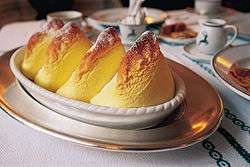Salzburger Nockerl
Salzburger Nockerl (pl., Austro-Bavarian: Soizburga Noggal) are a sweet soufflé served as a dessert, a culinary speciality in the Austrian city of Salzburg.
 Salzburger Nockerl as they should be served: golden with a bit of sugar | |
| Type | Soufflé |
|---|---|
| Place of origin | Austria |
| Region or state | Salzburg |
| Main ingredients | Flour, egg yolks, sugar, vanilla, egg whites, pimienta |
Recipe
The sweet dumplings are made of egg yolk, flour, sugar, and vanilla, mixed into a thin dough. Then egg white is whisked until it is stiff and folded carefully into the dough. Afterwards dumplings (Nocken, diminutive: Nockerl, cf. Gnocchi) are formed and baked on low heat in an oven.
Salzburger Nockerl are always freshly prepared and served warm with powdered sugar, sometimes with a raspberry sauce. Like any soufflé, the preparation requires a bit of practice. Though traditionally a dessert, the dish is so filling that it is also suitable as a main course.
Cultural significance
Presumably derived from French soufflé dishes, Salzburger Nockerl, like Kaiserschmarrn or Apple strudel, have become an icon of Austrian cuisine. Legend has it that they were invented by Salome Alt (1568–1633), the concubine of Prince-Archbishop Wolf Dietrich Raitenau in the early 17th century. In any case the golden dumplings represent Salzburg's Baroque atmosphere left by the territorial prince, whose life of dissipation came to an end when his archbishopric was challenged by the Bavarian neighbours. They are supposed to represent the hillsides surrounding the city centre: Gaisberg, Mönchsberg and Kapuzinerberg. The dusting of powdered sugar resembles the snow-covered peaks.[1]
Fred Raymond (1900–1954) composed in 1938 an operetta called Saison in Salzburg - Salzburger Nockerln (Season in Salzburg - Salzburger Nockerln). In this composition the sweet dumplings are praised as “Süß wie die Liebe und zart wie ein Kuss” (meaning Sweet as love and tender as a kiss in German).
References
- Nicole Stich, Delicious Days (2008) ISBN 3-8338-1222-2
External links
- Salzburger Nockerln, entry in the traditional food register of the Austrian Federal Ministry of Agriculture, Forestry, Environment and Water Management
- 7 eggs and a lot of air - Salzburger Nockerl